How Jesus Died
A Medical/Forensic look at the Crucifixion of Jesus
Below is a look at what Jesus Christ physically suffered for our sake on the cross. We also must keep in mind that along with this, He was also suffering mentally and spiritually. What wondrous love our God has for each and everyone of us!
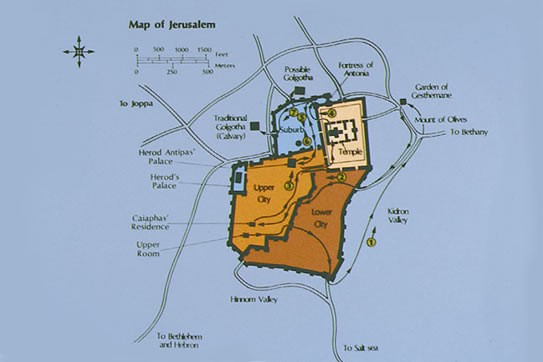
The journey of Christ's Passion and Death begins in the Garden of Gethsemane. We recall in scriptures that He went there after the Last Supper to pray. Gethsemane means Olive Press so we know that it was an olive orchard, it would have been springtime so the olives would have been ripe and smelling good. The people of that time used to set up gardens to remind them of paradise and of God’s glory and beauty, they were supposed to represent the Garden of Eden. This would have been a beautiful place. But for Jesus, there were other things on His mind. We read in the Gospel of Luke that as He prayed, His sweat became like drops of blood. That is a medical term called Hematidrosis which happens when someone is under great stress because they know they are about to die. Because of this stress and anxiety, the tiny blood vessels around the sweat glands burst due and mix with the sweat. This is then brought to the surface with the sweat, appearing and being, droplets of blood. Hematidrosis leaves the skin extremely sensitive. Minor pressure on the skin could result in excruciating pain. Those suffering from Hematidrosis often scream in agony at the slightest touch because their skin is so sensitive.
Late in the night, Judas comes with a mob to arrest Jesus. We read in the scriptures that Judas betrays Jesus with a kiss. Many people are often curious why this is, and it actually makes a lot of sense. The people of that time didn’t have the flashlights that we had today; they carried torches and small oil lamps which, in comparison, didn’t give off as much light. Jesus and his apostles would have all been wearing white, they would have had beards, and would have had their heads covered. It would have been hard to distinguish them apart. Therefore, Judas says, “The one I kiss will be him.†But imagine how painful it was for Jesus to be kissed after the blood vessels beneath His flesh had burst.
Late in the night, Judas comes with a mob to arrest Jesus. We read in the scriptures that Judas betrays Jesus with a kiss. Many people are often curious why this is, and it actually makes a lot of sense. The people of that time didn’t have the flashlights that we had today; they carried torches and small oil lamps which, in comparison, didn’t give off as much light. Jesus and his apostles would have all been wearing white, they would have had beards, and would have had their heads covered. It would have been hard to distinguish them apart. Therefore, Judas says, “The one I kiss will be him.†But imagine how painful it was for Jesus to be kissed after the blood vessels beneath His flesh had burst.

After taking Jesus from the garden, He was questioned by Pilate, Herod, the Sanhedrin (Jewish leaders who wanted Jesus killed), etc. He was also mocked, we read that the mob blindfolded Him and punched Him, mocking Him by asking to prophesy which one had hit Him.
It is important to remember that throughout this time where He was harassed and questioned He did not have anything to eat or drink, nor did He sleep. His body would have been fatigued and it is likely, from the Hematidrosis that He would have been dehydrated.
Early in the morning, Pilate had enough and wanted to satisfy the Sanhedrin. He thought by having Jesus scourged it would be enough. Scourging has got to be one of the most terrible tortures there are. When a person was scourged, they were tied naked to pole and whipped several times. The Romans used a flagrum or flagellum (plural flagra) to do the scourging. This was a wooden handle which thongs of rawhide were attached onto which lead, bone, glass, and spikes were attached at the end arrayed in a dumbbell-shaped pattern. When flicked at a body, the dumbbells would wrap around the victim and imbed into the flesh, once it is pulled out, the victim would bleed profusely. Over a series of beatings a midst of blood would envelope the area around the victim. The victim was soon unrecognizable. With Jesus’ skin being extremely sensitive from the Hematidrosis, the pain Jesus would have experienced would be unfathomable. By Jewish law, a person was only allowed to by scourged a maximum of 40 times, usually they only scourged them 39 times because 40 was an unlucky number. However, Jesus was not tried under Jewish law, He was tried under Roman law. By Roman law, there was no maximum number. If the victim were going to be crucified, they would only beat them mildly so they would still have some strength, if the victim were not going to be crucified, the Romans were allowed to beat the victim within an inch of their life. Jesus, at the time of the scourging, was not going to be crucified! There are over 160 scourge marks on the Shroud of Turin. The Roman flagrum matches precisely the scourge marks seen on the Shroud of Turin.

While a body is being scourged water, and other fluids, gather around the pleural sac near the heart and lungs. This is called pleural effusion and plays a significant part in the scriptures, as we will soon see. Jesus would have also lost a lot of fluid in the form of blood and sweat, making him very weak.
Once Jesus was properly scourged, His torturers sought the need to humiliate and torture him more. They draped a rough cloth over Him and placed on his head a crown of thorns. Most people think of the crown of thorns as a circlet, how many have envisioned this? In all actuality, the crown was more likely a cap; this would have been easier to create in that time because the Roman’s did not have hand armor. It would have looked more like a cap—after all, king’s crowns in that day were actually made out of flowers in a cap-like shape, a thorny cap would sufficiently mock Jesus as the “King of the Jews†and keep with the norm of the day. It is believed that the crown of thorns was made from a base of a Zizyphus Spina Christi plant, filled in with the Gundelia Tournefortii plant which, in the springtime, has one to two inch thorns as well as flowery bulbs. The cap, or crown, of thorns is significant to Jesus. He is the only recorded historical figure ever to be tortured with a cap of thorns. This was in order to mock Him being the “King of the Jews.â€
Once Jesus was properly scourged, His torturers sought the need to humiliate and torture him more. They draped a rough cloth over Him and placed on his head a crown of thorns. Most people think of the crown of thorns as a circlet, how many have envisioned this? In all actuality, the crown was more likely a cap; this would have been easier to create in that time because the Roman’s did not have hand armor. It would have looked more like a cap—after all, king’s crowns in that day were actually made out of flowers in a cap-like shape, a thorny cap would sufficiently mock Jesus as the “King of the Jews†and keep with the norm of the day. It is believed that the crown of thorns was made from a base of a Zizyphus Spina Christi plant, filled in with the Gundelia Tournefortii plant which, in the springtime, has one to two inch thorns as well as flowery bulbs. The cap, or crown, of thorns is significant to Jesus. He is the only recorded historical figure ever to be tortured with a cap of thorns. This was in order to mock Him being the “King of the Jews.â€

When the cap of thorns was placed on Jesus’ head, the spikes would have irritated or penetrated the trigeminal lobes in the front of the head as well as the greater occipital lobes in the back of the head. An immense amount of pain would start from the head and spread throughout the whole body. People who have damaged either of these lobes today usually freeze in pain; most of them commit suicide because the pain is so great and doesn't go away. To make matters worse, Jesus’ torturers mocked him and hit him on the head with reeds forcing the cap of thorns to penetrate further into His skull.
Shortly after his scourging, Pilate ordered that Jesus be shown to the Sanhedrin, they still were not satisfied. It was obvious to Pilate that the only way he could satisfy the Sanhedrin was to have Jesus crucified. Finding no fault in Jesus, Pilate had the people decide who should be crucified in the hope that they would request Jesus to be released and the other prisoner, Barabbas, to be crucified. However the crowd shouted for Jesus to be crucified...we, by our sin, shouted for Barabbas; therefore, after washing his hands, Pilate gave the order for Jesus’ death.
It is important to note that while Pilate is given a sort of "wimp" portrayal in the Scriptures, he was removed from his office in 35 AD for being to brutal to his people. It is more likely that he had a larger and more prominent role in Jesus' suffering and death than the Scriptures indicate.
Once the condemnation was made, Jesus would have been prepared for crucifixion. The Romans would have the victims carry the patibulum which was the horizontal part of the cross. This was an unfinished timber, very rough, weighing between 70-120 pounds and was meant to be used over and over again. Normally the victims carried the patibulum naked for the hour’s walk, this was to increase shame. Jesus, we read, was clothed in a garment during this time and stripped when He reached Golgotha. Either way, the rough timber still would have been brutal on the back of a scourged man; the weight would have been unbearable in His weakened state. Furthermore, the Romans, when there were multiple victims (usually around 15, in Jesus’ case we know there were at least two), would tie their ankles together to decrease the chances of them trying to run away. A consequence of this was that when one fell, the rest would fall with them.
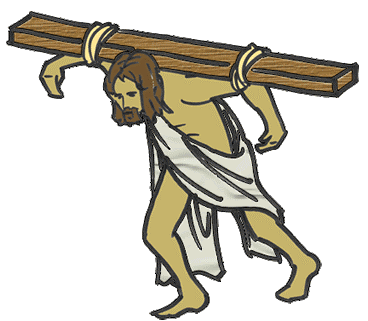
It is no wonder that we read that after Jesus fell, the Romans appointed the help of Simon of Cyrene to carry the patibulum. Jesus, by then, was in so much pain from the scourging, and was so weak from not having any food, water or rest. The Romans would not have wanted Him to die before He could experience crucifixion. He wasn’t going to get away that easily. Still, however, Jesus would have been mocked, punched, and tripped by the crowds that gathered as well as spat at. They were usually Gentiles, it should be noted that in that time there was a strong dislike between the Jews and the Gentiles.
There was still no relief in sight when the victims made it to Golgotha (known as the place of the skull). Golgotha, like similar places in other cities of this time, was a place outside the city where the citizens would bring the criminals and orphans who died to be eaten by the rats and birds of prey, as well as to rot. When archaeologists excavated such places in 1890, the stench was so great they had to take 15-minute shifts in order not to pass out. Chances are that as Christ and the other victims climbed Golgotha, there was a tremendous odor. The ground would have been muddy from the dirt and blood of others victims, and the place was probably littered with rotting corpses, rats, and flesh-eating birds. It was not a pretty sight. When Jesus reached the place where the stipes was (this was the vertical part of the cross, a very thick and rough timber met for several uses). We read that He was stripped. The best example I have ever heard of to imagine the sort of pain that would have been for Jesus to endure is to think of a time when you had a band-aid on and it is ripped off by you or someone else. Imagine those band-aids all over your body ripped off all at the same time. Now multiply that pain by a hundred - that is probably how painful it was for Christ to be stripped. The soldiers were not merciful. All of his wounds from scourging would have been reopened; any bleeding that had been clotted would have resumed.
After He was stripped, Jesus would have been laid down on the patibulum whereupon 7-inch nails were driven through His wrists, not His hands, His wrists! Despite what art tells us, the Romans were experienced at crucifixion, they knew that if you nailed someone by the palms, the nail would rip through the hand and the victim would fall off the cross. The palm could not support the weight of the body. However, if a nail were driven through the wrist in a place called The Space of Destot, the three wrist bones located there would have moved aside creating a hole for the nail to go through. The wrist would also be able to support the weight of the body. In biblical Greek the word "yad" is the same for wrist and hand, that is why in our Bibles the word hand is used and art usually depicts the nails in Jesus’ palms.
When the nails were driven through the wrist, the pain the victim would have experienced is almost unfathomable. The nail would have irritated or ruptured the median nerve causing what is called Causalga, which causes a lightning sharp pain that spreads throughout the entire body. Patients today who suffer from this are in so much pain not even morphine can help to relieve it. Also, when the median nerve is damaged, as discovered by Dr. Pierre Barbet in 1932, there is a sudden and permanent reflex of the thumb snapping inward to the palm, this is similar to trigger finger. From this point forward, the victim would have no use of his thumbs.
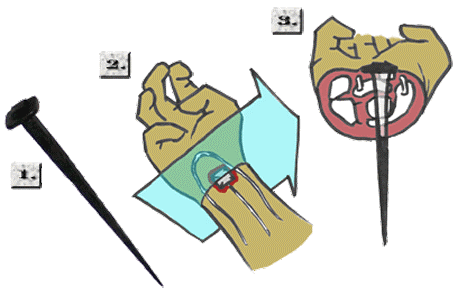
After Jesus was nailed through the wrist He would have been hoisted up onto the stipes and a nail would have been driven through His feet. This would cause rupture or irritation to the plantar nerves which would have the same type of pain that is associated with the median nerve in the wrists.

It is important to note that while Jesus was on the cross He would have been completely naked. This was intentioned to bring about a great amount of shame and humility, to show that that victim is helpless and has nothing, as well as to show the power of the Romans. It was not uncommon that while victims were on the cross, birds of prey would be nipping at their flesh and insects would feast on them covering them as they do with freshly hit road kill. The pain and humiliation Christ would have been going through is indescribable.
To make matters even worse, Crucifixion is a slow process of, among other things, suffocation (more properly, asphyxiation--the choking on your breath). In order to inhale the victim had to hang by the nails in their wrists.

It is important to note that while Jesus was on the cross He would have been completely naked. This was intentioned to bring about a great amount of shame and humility, to show that that victim is helpless and has nothing, as well as to show the power of the Romans. It was not uncommon that while victims were on the cross, birds of prey would be nipping at their flesh and insects would feast on them covering them as they do with freshly hit road kill. The pain and humiliation Christ would have been going through is indescribable.
To make matters even worse, Crucifixion is a slow process of, among other things, suffocation (more properly, asphyxiation--the choking on your breath). In order to inhale the victim had to hang by the nails in their wrists.
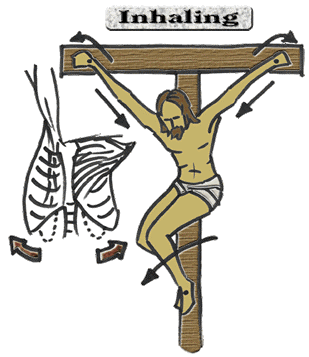
However, to exhale, the victim had to transfer their weight from their wrists to their feet pushing on the nail in their feet in order to lift themselves up.
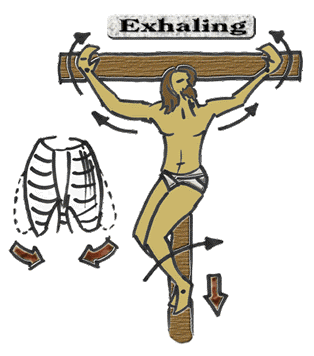
This constant up and down motion would have caused excruciating pain from the nails, as well as the back rubbing up and down the stipes. The cap of thorns (providing Jesus was still wearing it on the cross, most likely He was since that would add more pain and shame to the Crucifixion) would have been constantly moving on His head by hitting the stipes. There was no comfort on the cross.
While Christ was on the cross His body would have been going through a variety of states. His stomach would have stopped functioning all together, possibly causing the stomach acids to drain into the intestines. His heart would be beating faster and faster, His lips would begin to protrude from His mouth, and His mouth would become so dry, His tongue would dry out and cleave to the roof of His mouth.
This would all cause him to have an extreme thirst which is noted by Scripture when He said, “I thirst.†It was then that the scriptures say that a soldier took a sponge and dipped it in gall and put in on a hyssop branch for him to drink. The hyssop branch is a big clue to what type of cross Jesus was crucified on. In that time there were many forms of crosses (St. Andrew’s, long, etc.) but since hyssop only grows two to four feet, we know that Jesus was on a Tau cross which was a low hanging cross probably about eight feet in height.
The gall they would have given Him would have been one of two things. Either a mold wine mixed with myrrh which would have acted as an anesthetic, or, which is more probable, a very strong and bitter vinegar drink to increase the suffering.
There would not be enough blood going to all His muscles, even though the heart was beating ever faster. All of His systems would have begun to shut down. He would lose control of his bowels causing further humiliation; sweat (high in urea do to the beating He has endured) would have covered His body as well as His blood. His legs would have been unbelievable swollen. His blood pressure would be extremely low, He would be breathing very heavily until finally His heart would stop.
It is theorized that Jesus either died by suffocation or by three types of shock: hypovolemic shock-which is the loss of blood and fluids, traumatic shock-caused by all of the injuries He had endured, and cardiogenic shock-which is when the heart fails as a pump due to previously mentioned types of shock.
Because the Sabbath was approaching, the Jews asked that the legs of the victims be broken in order to hasten their death. This process is called Crucifragium and it causes the victim to suffocate because they were no longer able to exhale since they could not push on the nail in their feet to lift them up. However, when they came to Jesus they saw that he was already dead. Instead of breaking His legs, they decided to take a lance and thrust it in His side. According to John, when they did this blood and water flowed from His side. Most people take this as a miracle, but again, this is forensically correct. When the lance would have pierced his side (penetrating the space between the fifth and sixth ribs) it would have pierced the heart, pulling out the blood from it, followed by the watery serum from the pleural effusion gathered in that area during the scourging. Since it looked like water, John called it water, not knowing that it was really a watery serum from the pleural cavity.
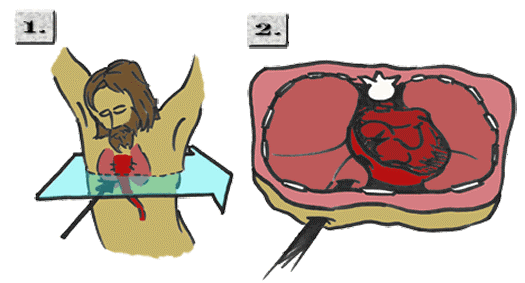
Once Jesus was pierced He was taken down from the cross. There scripture says that Joseph of Arimathea, a good friend of Jesus (some claim that he is really Jesus’ great uncle which is a sensible and plausible theory), asked for permission to take Jesus’ body and bury it. Permission was granted and he wrapped the body in a linen cloth and Jesus was buried “according to the burial customs of the Jews.†Most people think that this means that he would have been washed; this is true in Jewish custom unless the person dies a violent death! When this happens a body is not to be washed because it may contain lifeblood on it. Lifeblood is the blood that flows from the body after a person dies. It is considered very sacred to the Jewish people. It is the blood that gives life, the blood that sustains life. It is the blood of atonement for sins. When lifeblood flows from the body, people must collect it and have it buried with the body, if there is too much lifeblood to be collected, a person must collect a quarter-log of blood which is equivalent to one and a half eggs. That is the same amount as a glass of wine! You can almost hear Jesus say “Take this all of you and drink from it, this is the cup of my blood [the life blood, the blood that gives life, the blood that sustains life, the blood of atonement poured out for your sins]. Do this in memory of me.†Jesus knew what He was talking about when He said, “this is My blood.†His Apostles knew with greater depth than we can imagine how sacred and important this was. This has a great amount of importance in the Crucifixion and how Jesus was buried.
Since He was not washed, and wrapped in linen cloth according to the Jewish customs, it gives more possibility to our next topic---The Shroud of Turin.
